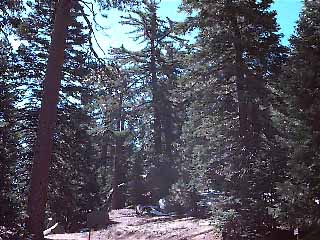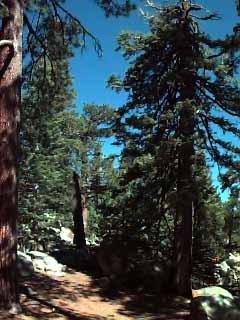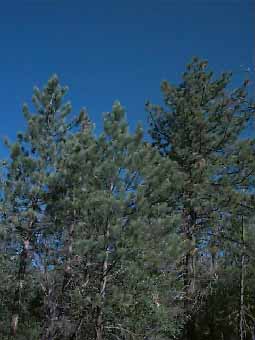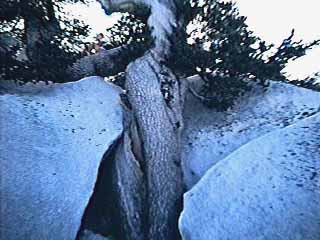
© copyright 2000 Michael P. Hamilton, Ph.D.
Ecosystem Management vs. Forestry: can we reconcile biodiversity issues in the remaining old growth forests?

May 28, 1997:
A group of us met today with the U.S. Forest Service officials to go over their rationale for cutting 120 ancient Jeffrey Pine, Sugar Pine, White Fir and Incense Cedar trees in and around the Black Mountain Group Camp and Boulder Basin Campground. The meeting was supposed to be between the members of the Idyllwild Environmental Group and the USFS district resources officer, district biologist and district forester. To our surprise it ended up including a reporter from the Town Crier, the district ranger, and several local wood cutters including the contract timber operator who cut the trees at the Black Mountain Group Camp. Needless to say, the meeting wasn't exactly what we had expected!
We spent about an hour in the ranger station at Idyllwild expressing our views about the need to preserve old growth trees until studies could be shown that cutting them would not have an adverse impact on the ecology of Black Mountain and nearby Fuller Ridge. What we were told was that studies had been prepared that indicated there would not be a significant impact, but when we asked to see these studies we were told that we could not have them unless we requested them under the "Freedom of Information Act" guidelines. Ironically the biologist who conducted the survey was right there with us, but would not elaborate on what she had found or how she conducted her survey. Typically these surveys amount to nothing more than an afternoon walk around, looking through binoculars and attempting to find active bird nests. The list of sensitive species for the National Forest includes many taxa that cannot be seen by a daytime walking transect, because the animals are nocturnally active, live in burrows or under rocks, or are seasonal migrants. Studies of multiple species require sampling using specialized trapping systems over the course of many days, and at different times over the year, and applying techniques that are specific to each species, or group of related species being studied.

The flammulated owl, one of the only north American migratory owls, requires mature conifer forests for breeding and nesting. Dr. Norm Mellor has been taking visiting ornithologists to the Black Mountain Group Camp for decades to listen to the breeding chorus of this little owl. That habitat was eliminated by the recent logging.
Later we drove up to Black Mountain, then parked in the Group Camp parking lot and were met by the timber contractors and wood products people who had been invited by the Forest Service to help "balance" the viewpoints that were being expressed. What we began hearing from the USFS forester and their timber operators was a professionally out-of-date, and unnecessarily simplistic, rationale for logging old growth trees as the only effective way to improve forest health and reduce a fire hazard. The original scoping letter that was sent to me several years ago, described the need to cut a few trees that posed a hazard to campers...trees that were rotting and leaning over campsites, outhouses or parking lots. Also trees that were damaged by campers over the years and became infested with parasites and needed to be removed to stop spreading of pathogens. When I commented on this proposal, I was not against this scale of vegetation management, it seemed to me that what was being proposed was the removal of a few dozen trees from each of the camgrounds that would protect the public from a liability, and then the planting of new trees to replace what would have to be removed. We listened to the timber operators echo the foresters discussion of the need to remove "over mature" or "decadent" trees that were purportedly hazardous to the forest itself because they were too big, shaded out the ground where seedlings deserved to grow, and posed a fire hazard, since 100 years of fire supression had allowed these species to gain an advantage. According to the Forest Service silviculturalist (a tree growing expert) nearly 50% of the basal area (a unit of tree volume measurement) of this stand should be removed to encourage more rapid growth of the pine species. Consequently, non-commercially important species like Incense Cedar and White Fir were crowding out the Jeffrey Pine and Sugar Pine, competing for light and water and space, and causing the pines to undergo stress.
From what I was hearing, the project had been expanded from being a straight-forward tree hazard project to a small-scale logging operation with the goal of improving the forest for the benefit of a couple of species of pines, and at the expense of several less valuable tree species (and of course all the other species besides trees that depend on the old growth conditions). The USFS foresters and their contract loggers made is appear that there was a real crisis on hand, and only through the action of cutting out 250 cords of wood, would they be able to save the old growth forest from destroying itself!. This perceived crisis mean't that the Forest Service could basically ignore the other issues that logging might impose, such as impacts to plant and wildlife habitat, visual esthetics in and around the campground, and the cumulative effects on the old growth mixed conifer forest ecosystem from the numerous logging operations that have already been conducted on Black Mountain over the years. One point we attempted to make, but was tactfully ignored, was that ecologists have made rapid advancements in understanding of our local ecosystems and by their scientific investigations have offered forest managers new tools to identify and protect biodiversity, while providing a sustainable yield of valuable forest products and services.
.
When you walk through an old growth forest, you are likely to notice mature trees of all ages, relatively few seedlings and saplings, large standing dead trees called snags, downed logs on the forest floor, large fallen logs in streams, trees that areover 200 years old, and little or no evidence of logging
In our meeting there was disagreement over the relationship between forest health and fire suppression in mature or "old growth" mixed conifer forests. Tall mature trees have survived countless wildfires because they have thick bark that insulates the cambium, and lower branches have long ago broken off thus reducing the fuel ladder that allows a fire to move from the ground up into the crowns. Dense stands of younger, even-aged trees, like most of the trees in and surrounding Idyllwild, are more prone to outbreaks of bark beetles and disease, have lower diversity of associated wildlife species, and are far more flammable because they dry out faster and have branches close to the ground.

To efficiently reduce the fire hazard caused by 100 years of fire suppression, thin the understory shrubs and second growth trees, but not the biggest and oldest trees that have already survived centuries of wild fires.
As I have stated previously,
An old growth forest is more than a stand containing old trees...it
is a complex, living ecosystem that supports numerous species
of plants, wildlife, and insects requiring conditions that do
not exist outside mature forests. Without over mature trees in
old growth forests, many species would decline and eventually
go extinct. More than 300 plant and animal species depend upon
mature forests in the San Jacinto Mountains. In fact, 40
species on Black Mountain and in Dark Canyon are so rare
that they are candidates for special federal and state protection.
Unfortunately, the Forest Service makes their logging decisions
without conducting sufficiently detailed studies to determine
which old growth dependent species are affected by selective
cutting and associated soil disturbance. The big picture today
is ecosystem management, which legally requires a detailed, scientifically
accurate approach be taken before logging that identifies strategies
that balance protecting plant and wildlife populations within
the objectives of forestry.

This 1,800 year old limber pine located near the summit of San Jacinto Peak would be considered "decadent" by current USFS policies, and subject to salvage logging if it were not located within the state park wilderness. Yet this tree, the oldest recorded tree in the entire mountain range, contains priceless data about global climate change stored within its tree rings.
So where do we go from here? Can we reconcile biodiversity issues in the remaining National Forest old growth forests? The US Forest Service claims that they lack the money, the in-house expertize, and the rationale to take ecosystem management to a level where an un-biased emphasis is placed on all species. Perhaps it is time that they professionally accepted the concept of coordinated resources managment (which they claim to endorse) and allowed all of us to help them as an equal partner in the stewardship of our priceless natural heritage. What I see as a necessary step is to define a "Ecosystem Bill of Rights," a document that spells out what the notion of ecosystem management and stewardship means, simple and straight forward...
